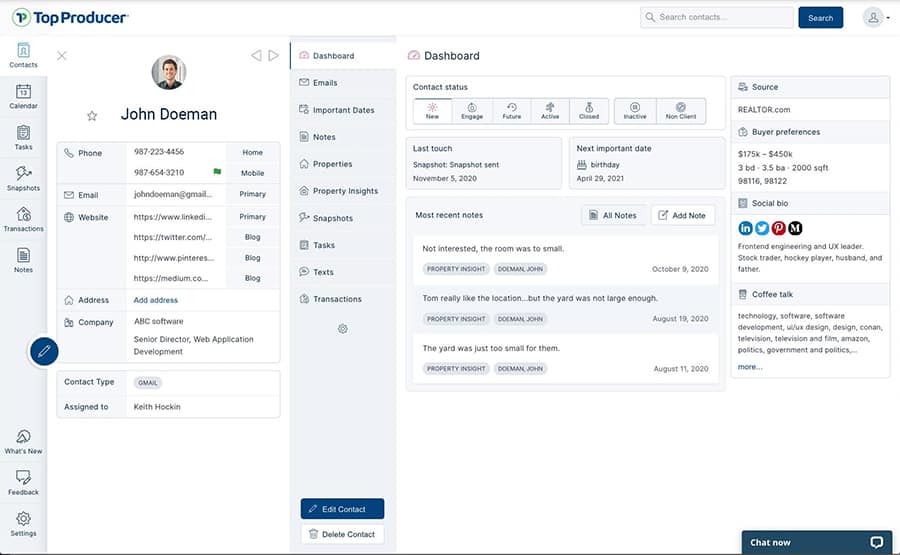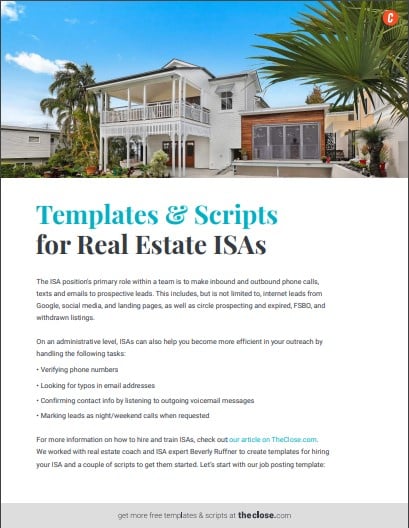You’ve probably heard of agents, teams, or brokerages with a real estate ISA, also known as an inside sales agent—but is it a good choice for your business? ISAs can be real game changers for real estate businesses of all shapes and sizes because they allow you to focus on serving clients. Let’s dig into what an ISA in real estate is, what they do, and when and how to hire one.
What Is an ISA in Real Estate?

An ISA in real estate is a team member whose primary job is to find and connect with new leads. Real estate agents have to find new leads to continue to grow their business, but they’re also responsible for serving existing clients, managing transactions, and marketing. With an ISA, a realtor or real estate team can focus on clients and real estate transactions instead of making cold calls or sending endless follow-up emails and messages.
The acronym “ISA” has become controversial in the real estate industry, especially since online lead generation began. This is because the ISA real estate meaning is often unclear, and many agents don’t treat the position as they should. Instead of seeing ISAs as a valuable source of real estate business growth, agents will often hire a friend or family member who needs some extra cash. Plus, agents who don’t put effort into proper training or creating systems won’t see as much success in this role.
What Are the Responsibilities of an ISA?
An ISA is the person who gets into the nitty-gritty of lead generation and converting clients, so their specific tasks and responsibilities will vary significantly. For example, agents who generate leads primarily from social media will have different functions than agents who focus on direct mail or phone calls.
In general, the bottom line of an ISA real estate’s job is to find you as many new clients as possible. This means that their responsibilities can include the following:
- Prospecting new leads from a variety of sources
- Qualifying new leads
- Making cold calls
- Sending texts and emails
- Following up with old leads or previous clients
- Making appointments
- Managing data in your CRM (client relationship manager)
- Researching market trends and local data
ISA Skills & Qualities
Since an ISA for real estate directly impacts your business growth, you must look for a specific type of person. Finding the right person for the job will take time and effort, but it will make all the difference in building a strong real estate team. Realtors with years of hiring and working with ISAs say that personality is everything—it’s not just about looking for a chatterbox or a people person (although those are important!), but about finding a mix of the right traits and setting them up for success.
Here are a few of the most important qualities to look for in a real estate ISA:
-
Outgoing or a “people person”: The right personality type loves people, is curious about others, and wants to learn more about who they are talking to. They are relationship-focused and don’t only focus on pushing a sale.
-
Great communicator: Communication is a skill that can continually be improved, but it isn’t always included with outgoing personality types. Look for someone who can clearly share their thoughts and address issues calmly and confidently.
-
Structured and organized: A great ISA thrives on systems and expectations.
-
Team player: Consider asking candidates about their experience in sports. An ISA is a crucial part of a real estate team, and they will have the most success when they know how to support the team as a whole instead of just their accomplishments.
-
Problem solver: Find someone who is always looking for solutions. The best ISAs in real estate can work within a system and identify ways to improve their role and the organizational processes.
-
Tech-savvy: A huge part of a sales agent’s job is working in different real estate brokerage software types, from CRMs to lead generation platforms to social media. Choosing a candidate who can explore technical platforms will simplify the process and save hours of confusion.
-
Resilient: Real estate ISAs are like the front lines of your business, and they will inevitably (and repeatedly!) get hung up on and be called unkind words. They often hear more no’s than yes’s, so the best candidates can brush themselves off and keep going after discouragement.
-
Sales or service experience: Finding someone with experience in the sales or service sectors is helpful but may not be a requirement. Experience in challenging situations gives people a thicker skin.
Pro Tip: Make your own list of the most important qualities in an ISA, and consider which qualities are learnable or negotiable and which aren’t. It is unlikely that you’ll find a candidate who has every single quality you want already developed. However, you can still get incredible results from finding a determined, dedicated candidate willing to improve their weaker qualities and learn from your experience and expertise.
Compensation for ISAs
ISAs in real estate are unique because they are typically paid a base salary with a percentage of commission. It can be tempting for agents to pay only by commission, but ISAs typically have a different payment structure because they work more traditional hours generating leads. Of course, you can offer a different payment structure, but it may not be appealing to high-quality sales agents.
For American ISAs, ZipRecruiter reports the national average base salary to be $44,158 per year. On the other hand, Glassdoor reports that ISAs make a median annual salary of $86,000, but this likely includes commissions.
ISA Real Estate Hiring Guide

Once you have an idea of the type of person you want to hire, you can start the hiring process. If you’ve never hired an employee or freelancer before, here are my tips for hiring and evaluating a strong ISA for real estate.
When to Hire an ISA
Agents thinking about hiring an ISA often fall into two categories:
- Agents who have a ton of leads but need help converting them into appointments and clients
- Real estate professionals who are building a team and looking to take their business to the next level
If you’re still building your client base or learning the ropes of the industry as a new real estate agent, it’s probably not time to hire an ISA just yet. On the other hand, many busy agents hire an ISA without the right expectations or mindset. They think they don’t have the time to nurture leads, but the honest truth is that they just don’t want to do it. If you want real results from hiring an ISA, you must have systems in place to set the position up for success.
Where to Find ISA Candidates
- Online job boards: Try your hand at posting a job on Indeed, Glassdoor, LinkedIn, or even in Facebook groups
- In-person connections and referrals: Ask your current real estate team or your network of real estate professionals if they know of any candidates who would make a great ISA.
- Real estate networking events: Search on Facebook or Meetup.com for real estate networking events and spread the word that you’re looking to hire.
- Social media: Share on your social media platforms that you’re looking for a new team member with specific qualities.
- Colleges or training programs: Students are usually looking for job opportunities and are eager to learn new skill sets. Make connections within colleges or programs in your area and look for job fair events.
- Online freelance platforms: Another great way to find a candidate with varying levels of experience is through Fiverr, a freelance marketplace. It may be more difficult to find a local ISA, but you can search through hundreds of freelancers who already know the ropes of real estate sales.
How to Reach Out to ISA Candidates
Your strategy for connecting with potential candidates should vary depending on how you find them. If you get a personal referral, a text, phone call, or email would be the best way to connect. On the other hand, if you choose to share a job posting online, here’s a template you can customize for your real estate business:
INSIDE SALES POSITION – [location/remote]
Are you an overachiever? Are you looking for a ground-floor opportunity where your hard work and effort are rewarded in compensation and knowing you are providing services that are proven to change lives? Are you looking for a company that challenges you to learn and grow? Do you want to be excited every day when you wake up, looking forward to doing something you know you can help, and more importantly, believing in what you are doing and being proud to be on the team?
Our company will challenge you to acquire more knowledge. You will be held to the highest level of integrity, be expected to work with a sense of urgency, and become an expert in our field of work, services, and proven methodology. As you grow with our company, you will see more opportunities unfold before your eyes. You will be a part of something that matters. And most of all, you will have fun because—as steadfast as we are in changing our industry—we are equally committed to a culture that rivals Google and Zappos.
We are looking for winners. We will help you win bigger. We aren’t looking for someone just to fill a seat and make some calls. We are hiring one key salesperson who meets our requirements, and we will invest in ensuring you have all the tools and resources you need to achieve your personal goals within our company. We won’t waste your time, so please don’t waste our time if this opportunity doesn’t resonate with you at your core. We are the real estate industry leader and only hire top producers.
To apply: To be considered for this position, send a resume to [company email] with your salary requirements. Please use the following as your subject line: INSIDE SALES NEEDED. Resumes without salary requirements and this subject line will not be considered.
Location: [area]
- Principals only. Recruiters, please don’t contact this job poster.
- Please, no phone calls about this job!
- Please do not contact job poster about other services, products, or commercial interests.
How to Interview Potential ISAs
Every business has a unique interview process, which should reflect your personality and brand in your business. However, an ISA for real estate needs to have both an outgoing personality, flexibility, and organizational skills.
You should interview multiple people to help you understand your candidate’s strengths and weaknesses. Here’s the process I recommend:
- First interview: This first chat is a get-to-know-you interview, not a decision interview. Find out their expectations in terms of hours and pay. Ask questions to evaluate their communication skills, personality, and willingness to learn. Tell them what to expect if they are called for a second interview and that you have other candidates and will get back to them.
- Second interview: Test how the candidate might perform in the role. Review some of your processes and scripts with them, and give them a few example scenarios to see how they’d respond. Do a few role-playing scenarios, and consider having them actually call a few old leads. Remember, you’re not looking for perfection! You can even have the candidates rate themselves after these exercises.
Training & Systems for ISAs
While finding the right person for the ISA real estate job is important, having systems and processes ready for them is even more critical. Even the best ISA candidate can generate underwhelming results if they don’t have the right tools or systems. The goal is to work smarter, not harder, and the more organized you are, the more organized your ISA will be—and the more they will convert. It’s as simple as that!
Keep in mind that if it isn’t written down, it will probably not be followed or even remembered. Having a training and best practices manual for your entire team is crucial, especially when onboarding a new ISA. Here are a few important factors in planning, organizing, and including in your training manual:
- Onboarding: This should include important information about other team members, your brand, mission statement, team goals, etc.
- Software training & access: Give the ISA access to your CRM, lead generation companies, and any other software tools you use within your business. Show them how to use each tool and answer their questions.
- Communication guidelines: Clearly describe how your ISA should communicate with other team members. For example, is email or Slack preferred? Make it clear who they should contact with questions.
- Performance goals & expectations: Write specific, clearly defined tasks and goals you have for your ISA, like calling five leads per day or updating the CRM each week.
- Accountability: Set up a regular time for your ISA to meet with yourself or a different team member to check their progress and productivity.
- Learning opportunities: Encourage your ISA to seek new resources and improve their skills by suggesting or offering mentorship or training programs.
Best Practices for Building Your ISA Team
Like the great Peter Parker once learned, with great power comes great responsibility. Hiring an ISA could be one of your business’s most powerful growth strategies, but only if you do it the right way. Here are some of the best tips for onboarding your ISA and building your team.
1. Have a System Ready
If you haven’t already mastered a few strategies that consistently generate new clients, hiring a real estate ISA can be challenging. Whether you buy real estate leads, market on social media, or focus on in-person networking, you should be able to transfer the information and strategies to your ISA. Remember what an ISA in real estate is and is not—by giving them clear expectations and strategies, they can build relationships most effectively (and quickly!) and send you new clients.
2. Set Up CRM Filters
Managing your real estate CRM is part of an ISA’s job, so they should know how the settings are set and when or how to change them. For example, it is ideal to have automated call filters in your CRM to identify different types of leads, like the following:
- New buyer and seller leads that haven’t been contacted
- Leads within the last 14 days that haven’t been contacted
- Active leads (like leads registered more than 14 days ago, leads with unknown phone numbers)
- Inactive leads (leads that haven’t been contacted within 30 days)

If you don’t already have a CRM that simplifies all of the communications in your business, it’s time to get one! Check out Top Producer, a real estate-specific CRM with a variety of automation for marketing and communication. It even has a 30-day free trial, so you can test it out.
3. Focus on Speed to Lead
“Speed to lead” is a commonly known real estate concept. It means if you don’t personally contact a new lead within a few minutes of them registering on your website or reaching out, your chances of ever contacting or converting them massively decrease. The benefit of having an ISA is that they are solely focused on reaching out to new leads—they won’t be busy showing houses when a new lead reaches out.
Make sure you teach your ISA about the importance of speed to lead and give them practical tips to follow through. Have them set up notifications for when new leads register and have scripts and strategies ready for the first phone call.
4. Provide Scripts
One of the best ways to set your ISA up for success is by answering the question, “What do I say when I follow up?” Give them premade scripts to help them ask the right questions and skip the learning curve of talking to potential leads for the first time.
If you want even more chances of success, give your ISAs a variety of scripts! Remind them that scripts don’t need to be followed word for word, but they will help guide the conversation to be most productive and trust-building. Here’s an example script an ISA can use with a potential buyer:
Lead: I cannot do anything until my company decides their move. We are at least six months away from anything happening.
ISA: Totally understand. In the meantime, what could I do that may be helpful for you?
Lead: I would really like to understand what prices are and what homes are going for.
ISA: Great, let me set you up to receive listings. What are you looking for in a home?
[Listen and note their criteria.]
ISA: This is great. I’ll set up a general search to give you an overall idea. How often would you like me to check in?
Lead: Oh, I don’t know.
ISA: I’ll tell you what: How about I just check back in a couple of weeks, ensure you are getting the listings, and see if you have any questions or need me to make any changes? We can just take this month by month until you know what is going on.
[Wait for response.]
ISA: We’re here to answer your questions anytime! I look forward to talking to you again.
5. Leave Room for Improvement
A strong ISA will take all the tasks of generating and nurturing leads off your plate. Over time, the perfect ISA will even improve your systems and become more effective. To see the most success from this position, make sure you intentionally create a highly collaborative relationship with your ISA.
The more you encourage feedback between you and your ISA, the easier it will be for them to bring new ideas and improvements to you. When you give them the training manual and access to software, use collaborative tools like Google Docs or Canva, where the ISA can make notes and update things as time goes on.
Frequently Asked Questions (FAQs)
Does an ISA need a real estate license?
No, an ISA does not need a real estate license. They are an important member of your real estate team, but they are not participating in real estate transactions. However, hiring someone with experience or familiarity with the real estate industry is ideal.
What are the benefits of an ISA?
An ISA helps qualify new real estate leads and prevents potential leads from falling through the cracks. They nurture leads, ultimately increasing the number of new clients you or your team have.
How much does an ISA earn?
Real estate ISAs typically have a base salary and additional commission income, so their wages vary. According to ZipRecruiter, the national average base salary for ISAs is $44,158.
Your Take
Having an ISA in real estate can help you or a team of agents be more productive and significantly increase their closings and income. However, there are some important notes to consider when hiring an ISA, so use our guide to help you in the process.
Do you have a great tip for hiring or training ISAs? Let us know in the comments.













Add comment